- Like
- SHARE
- Digg
- Del
- Tumblr
- VKontakte
- Flattr
- Buffer
- Love This
- Save
- Odnoklassniki
- Meneame
- Blogger
- Amazon
- Yahoo Mail
- Gmail
- AOL
- Newsvine
- HackerNews
- Evernote
- MySpace
- Mail.ru
- Viadeo
- Line
- Comments
- Yummly
- SMS
- Viber
- Telegram
- JOIN
- Skype
- Facebook Messenger
- Kakao
- LiveJournal
- Yammer
- Edgar
- Fintel
- Mix
- Instapaper
- Copy Link
Introduction
Believe it or not, exercisehtt balls have been around for thousands of years!
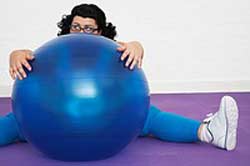
Interestingly, Hippocrates, the father of modern medicine supposedly stuffed sewn up animal skins with sand and used them as “medicine balls” to help people recover from problems such as back injuries.
In today’s world of modern fitness, exercise balls are everywhere. From your local gym to many of your friends’ houses you probably see exercise balls often.
If you are not a personal trainer you may not realize the potential each exercise ball has for exercise. Perform some of the best ball exercises and you will easily become a believer that the best exercise ball can be an integral part of your fitness program.
All exercises much be consistent with your goals. The different exercise balls available can help you achieve a variety of goals. Different exercise balls can be used together or separately, with or without other equipment such as barbells and dumbbells. There are many different kinds of exercise balls. They come in different colors, sizes and weights.
The three most popular and effective exercise balls are the stability ball, medicine ball, and BOSU ball.
Stability Balls: The Best Exercise Ball?
Stability balls are also known as Swiss balls, exercise balls and physio balls. When some people ask about exercise balls, they may be referring to the stability ball.
Stability balls are rubbery inflatable balls of various sizes and colors. They can be used to a variety of exercises for your whole body. The only muscle group which you cannot exercise solely with a stability ball is your upper body pulling muscle group (back and biceps.)
Stability balls are best used for stabilization, strength, and balance training exercises. Stability balls are also a good alternative to an office chair. When you use a stability ball as an office chair, you can decrease the chances of lower back pain and improve your posture.
You can also use stability balls in place of weight benches. If you are performing any chest or shoulder pressing exercises, you can use the supine bridge position on the stability ball. This makes a stable position where you can perform presses while keeping your core and legs exercising.
Since stability balls come in different sizes and strengths it is important to know how to choose the right size stability ball for you.
How to Choose a Stability Ball that Fits You
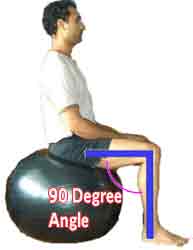 First of all, every stability ball is not created equally. The old saying “You get what you pay for,” is a good philosophy to use when buying a stability ball. Stability balls that pump up very firmly are the best exercise ball compared to balls that pump up flimsily. The flimsy exercise balls can be better for a few exercises where the firm balls cannot.
First of all, every stability ball is not created equally. The old saying “You get what you pay for,” is a good philosophy to use when buying a stability ball. Stability balls that pump up very firmly are the best exercise ball compared to balls that pump up flimsily. The flimsy exercise balls can be better for a few exercises where the firm balls cannot.
Even though different exercises may be better with a different sized stability ball, you have a size which is best for you. Stability balls usually come in sizes of 45, 50, 55, 60 up to 80 centimeters. If the packaging says a certain size is for a certain height, do not go by that. If you have short or long legs, this way of measuring will not work correctly.
You can find which size of stability ball is right for you by sitting on a properly inflated stability ball. If your legs in front of you form a 90 degree angle with your heels directly below your knees the ball is just about the right size.
Best Stability Ball
Duraball Pro
The stability ball I have used for over 3 years. I have used it for a good part of over 4000 training sessions and have only had to replace it once over a period of around 3 years.
The Duraball pro costs more than most stability balls but they are well worth it not only because of durability but also usability. When inflated properly the Duraball pro is hard, and will NEVER EVER will become lopsided.
Purchase a Duraball Pro
 Medicine Balls
Medicine Balls
Medicine balls weight from 2-30+ pounds. They are usually made up of dense rubber, or leather stuffed with sand or some other heavy material. Some have laces and some do not. The bigger they get, the heavier they get.
Medicine balls stake their claim as one of the best exercise balls because they are tremendous for power development. Explosive training is the medicine balls best use, although it is very versatile.
The medicine ball can also be used simply as a weight. Instead of holding a couple dumbbells, you can hold a medicine ball for certain movements. In some cases, holding a medicine ball is more ergonomic than holding another form of resistance. They are also good for uses similar to stability balls.
Some medicine balls bounce and others do not. You should know which kind you want before you buy a set. Bouncing medicine balls are better for exercises where you need to roll or bounce the ball. Medicine balls that do not bounce are better for catching because they are easier to grip.
Best Medicine Balls
Nike Medicine Balls
The best medicine ball is not as clear cut as the best stability ball. Medicine balls can be best judged by their durability. Nike’s medicine balls are made of hard rubber and bounce. Bouncing medicine balls are best for functional weight training when you want to bounce the ball.
Nike medicine balls look like new after years of intense work. You will be satisfied with Nike medicine balls but this is not to say you will be dissatisfied with other brands.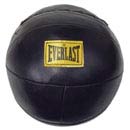
Everlast Medicine Balls
If you are looking for medicine balls with no bounce, Everlast medicine balls are the best. A sand filled core with a laced leather cover make Everlast medicine balls great for any exercises in which you do not want any bounce.
Everlast medicine balls are softer than the hard rubber balls so they can be easier on the wrists to catch as well as hurt less to get hit with if you are in sports such as mixed martial arts or boxing.
There are different styles of medicine balls which you can find below but the best exercise ball is the classic variety.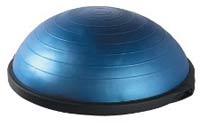
BOSU Ball
The dome shaped BOSU which is an acronym for Both Sides UP is really the BOSU balance trainer.
It was invented in 1999 by a guy named David Weck and has been heavily used in gyms across the world since then.
The BOSU can be used for a lot of the same exercises as stability balls. It is far more versatile than stability balls because it can be used for low level, beginner exercises as well as advance stabilization, strength and explosive power exercises.
The flat surface on the BOSU can be used for most of the same uses of the round side. In different exercises the difficulty will be increased or decreased by using the opposite side.
Many trainers believe that the best exercise ball is not even really a ball, but the BOSU balance trainer.
BOSU Balance Trainer Models
BOSU Pro Balance Trainer
The BOSU Pro Balance Trainer is the highest-end Balance Trainer product. It is designed for unlimited use in a commercial facility. It has a thicker bladder (dome) and a rubberized, non-marking overmold on the platform (bottom) for optimal grip on floors and more durability. It has a one-year commercial warranty.
BOSU Home Balance Trainer
The BOSU Home Balance Trainer is intended for home use. The product is designed to perform for many years used within a home, but is not warranted for commercial use. The platform (bottom) has non-marking rubber feet to prevent slippage on floors. This model has a 30-days manufacturers warranty.
BOSU Sport Balance Trainer – 55 cm
The BOSU Sport Balance Trainer is an entry-level Balance Trainer product. It costs less and is smaller than the Pro and Home versions, but one can still get an effective workout using this tool. This product is meant to make the BOSU Balance Trainer most accessible for people on a budget.
BOSU Sport Balance Trainer – 45 cm
The BOSU Sport Balance Trainer is ideal for sport-specific application and using multiple units at once. The smaller size enables you to position multiple units with close proximity to train specific athletic stances. These are also highly portable.
Buy the BOSU Balance Trainer
BOSU Ballast Ball
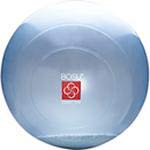 BOSU has come out with the new Ballast Ball which is a stability ball with a weighted liquid on the inside
BOSU has come out with the new Ballast Ball which is a stability ball with a weighted liquid on the inside
The ballast ball has been touted as better for seniors. The advantage is the ball won’t roll away during exercises and weights enough to use it for some strength training exercises such as the BOSU balance trainer.
More information about the BOSU ballast ball will be posted once it can be tested.
Buy the BOSU Ballast Ball
Where can I Buy the Best Exercise Balls?
You can fight the crowds, lines, and poor customer service at your local sporting goods store. If you want a more civilized way to get your exercise balls you can find the best exercise balls online at quality, trusted vendors.
The fitness products will be shipped to your door with no wasted time at the store. If only they would pump them up for you, which is a workout in itself.
Don’t Forget a Deluxe Exercise Ball Pump
Are there More Types of the Best Exercise Balls?
There are other forms of exercise balls out there, but the aforementioned balls are superior tools and you should consider using them before different types of balls.
Other Types of Exercise Balls Include
-
 Handle Medicine Balls
Handle Medicine Balls
Medicine balls with handles allow you to perform certain exercises without the added stress on the hands and fingers. The grip makes it easy to carry around the medicine balls during exercises. - RCK Ab Trainer Ball

Medicine balls with handles sticking out to the side. These medicine balls can be used to perform core exercises, abdominal exercises as well as push-ups. -
 Rope Power Balls
Rope Power Balls
Medicine balls with ropes attached. Can be used for rotational core strength. Rope power balls are great for anyone who wants to develop explosive power in the transverse plane such as tennis and baseball players.  Yoga Balls
Yoga Balls
Small sand filled bags to assist with posture. Usually 2 or 3 pounds. Yoga balls can also be used as a generic term for every best exercise ball.
More Exercise Ball Information Articles Written by Expert Personal Fitness Trainers
- Stability Ball Exercises
You know know that the best exercise ball may be the stability or Swiss ball. Put your new stability ball to use and perform some of these challenging exercises. - Remember to start off with the beginning exercises and master them before you try to progress and make them more difficult.
- BOSU Ball Exercises
Many trainers think hands down, the BOSU is the best exercise ball or half of a ball. Find exercises which you can perform in your home or at the gym. There are many resistance, power, balance and cardio exercises are unique to the BOSU. - Once you get comfortable with using the BOSU balance trainer, you can even begin to create your own exercises. When you use the BOSU for a while, it will most likely leave the impression on you of being the best exercise ball.
- Medicine Ball Exercises
Learn how one of the best exercise balls can be used for a whole workout which you can do in the comfort of your own home. You can also use medicine ball exercises in the gym to supplement your other workouts.
What Are the Best Ball Exercises?
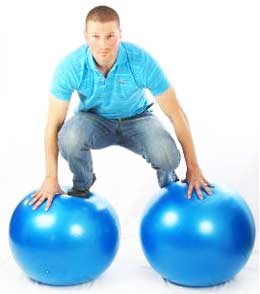
Which Ball Exercises are the Best Depends Entirely on your Fitness Goals
If you are trying to find the best ball exercise or any other types of exercise always keep your fitness goals in mind.
It is your goals which should be the primary determinant of your exercise selection, intensity, frequency and duration as well as most other aspects of your fitness program.
If you choose exercises which are not goal specific, it will increase the time it takes to achieve your goals. It also may cause you to get so frustrated about not getting the desired result, you will feel like quitting your exercise program altogether.
You may want to exercise more, but if you perform the correct exercises, you will achieve better results in your fitness program. It is possible to have an exercise program based entirely on the best ball exercises.
It is Highly Recommended that you use the Best ball Exercises to Supplement a Balanced Workout Program
Ball Exercise Advantages
To Know the Best Ball Exercises you should be Familiar with the Different Types of Exercise Balls

The best ball exercises challenge your stabilization. This is the most important advantage of working with exercise balls. Stabilization is important for the entire body. The body parts which stabilization is most important are the core and the shoulders.
Without proper core stabilization your body can not perform movements with the highest level of efficiency. Using the best ball exercises to improve your core will help the rest or your body be more stable, efficient and improve your balance.
If you use exercise balls, especially for body weight exercises such as push ups it will dramatically improve your shoulder stabilization. This occurs because all your muscles have to work together to stabilize your shoulders. This includes muscles which are not primary movers.
For example if you perform a machine chest press, everything is stable so only your primary muscles involved in the action are trained (chest, triceps.) If you perform a stability ball push-up, which is an unstable environment your body has to use all the extra muscles which help stabilize you so you don’t fall off of the ball or tremble.
Another very important aspect of improved shoulder stability is the reduction in the possibility of shoulder pain or injuries due to exercise. Shoulder pain is very hard to work around. It can even stop you from performing leg exercises.
So, which are the overall best ball exercises?
There are a Few of the Best Ball Exercises which Really Stand Out
These exercises are the best because it either very difficult or impossible to duplicate them using anything other than the different exercise balls which they use.
Remember, all exercises are goal specific. If you are not ready to use an exercise ball, these exercises will not be the best for you.
Always Perform each Best Ball Exercise with Strict, Proper and Controlled Form
Stability Ball Plank
The physio ball plank especially the dynamic version is the most intense body weight core exercise.
Proper form is necessary, if you experience pain in your lower back, stop immediately and do an easier exercise.
Position yourself right on the top of the stability ball. Put your forearms on the ball and make you have as much surface area on the ball as possible (elbows to fists.) Hold the plank position.
To increase the difficulty all you have to do is push your elbows forward a very small distance. This exercise is so simple you may not believe it is one of the best ball exercises, that is until you do a set.
Another method of increasing the difficulty of this best ball exercise is to lift a foot off of the ground. To make it extra hard you could abduct your foot out to the side. If you did so with ankle weights on, it would be yet another progression
Medicine Ball Push-Ups
Medicine ball pushups are great strength and stability exercises for your entire upper body push muscle group. This includes your chest, triceps, and anterior deltoids (front of shoulders.)
2 arm medicine ball push-ups are a tremendous workout for your triceps but also work your chest and anterior deltoids.
To start, put both your hands on the medicine ball. If you have your palms towards each other you will get a better grip on the medicine ball. Drop your chest all the way down until it touches the medicine ball and push back up. Keep your head up and repeat. If you can do 20 reps on your first try, give yourself a pat on the back.
1 arm medicine ball push-ups primarily work your chest and shoulder stabilizers as well as your core.
Start with your arms spread out to your normal to wide push up stance. Put one hand on the medicine ball and the other on the floor. Keep your head up and lower your chest toward the floor. Once you complete the push-up roll the medicine ball to your other hand.
Try to keep your hips level and of course do not let your knees touch the floor. If you can perform 20 reps on the first try that is very impressive. Remember, again proper form is of utmost importance when performing any of the best ball exercises
BOSU Walking Lunge, Twist, Push-ups
This may be the most challenging best ball exercise. It is actually a combination of many exercises. You will work your chest, triceps, core, obliques, shoulders, quads, hamstrings and glutes, not to mention your cardiovascular system.
It is best if you start in a hallway where you have at least 30 feet of space to walk. If you do not have space to walk forward, you can also perform standing in place. Pick up the BOSU ball and turn the blue part away from you!
Start by having the BOSU at your chest, lunge forward all the way so your knee is directly above your ankle. Your back knee should be 1 inch off of the ground. Extend your arms in front of you, and twist the ball over your forward leg.
Bring the ball back to the middle, set it on the ground next to your foot. Bring your front foot all the way back and keep it in the air. Perform a push-up touching your chest to the BOSU. After you perform the push-up, bring the foot which is still in the air all the way back forward. Keep your back knee down and do a full 1 legged lunge back up to the original position and repeat.
If you do this properly for 12 reps you may be ready to progress. You can add stationary lunges, push-ups and twists to your delight if you wish to make the best ball exercises even more difficult
As you can See, there are Many ways to Progress Basic Ball Exercises to become More Difficult
What you MUST KNOW about the Best Ball Exercises
- Stability Ball Exercises
The best stability ball exercises for every major muscle group. Use these exercises to supplement your workout program. Learn how more stability equals better results in strength, performance and body composition goals. - Stability Ball Workouts
Two workouts. One for if you want to have a workout with just a stability ball. Another stability ball workout for those of you who have a gym membership and would like to incorporate the physio ball for the majority of your workout. - BOSU Ball Exercises
Here are some of the best ball exercises using both sides of the BOSU ball. Use these exercises whether you have used the BOSU ball before or are a beginner. A good BOSU ball exercise idea would be to superset BOSU exercises in between your current weight training exercises. This would increase total workout volume and hopefully help you achieve results faster. - BOSU Ball Workout
You can get a complete, full body workout with just the BOSU ball. The BOSU ball can be used in your own home as well as the gym. One workout consists of exercises with just you and the BOSU ball. The other workout uses all the tricks of the trade along with the BOSU to create new challenges to make your workout not only more challenging, but fun. - Medicine Ball Workouts
Believe it or not, these hefty, rubbery, small balls can be used by themselves as part of a challenging workout program. Learn how stashing a medicine ball in your closet can be the only tool you need to have a challenging workout at home with very little equipment
7 Simple Exercise Ball Exercises for Beginners
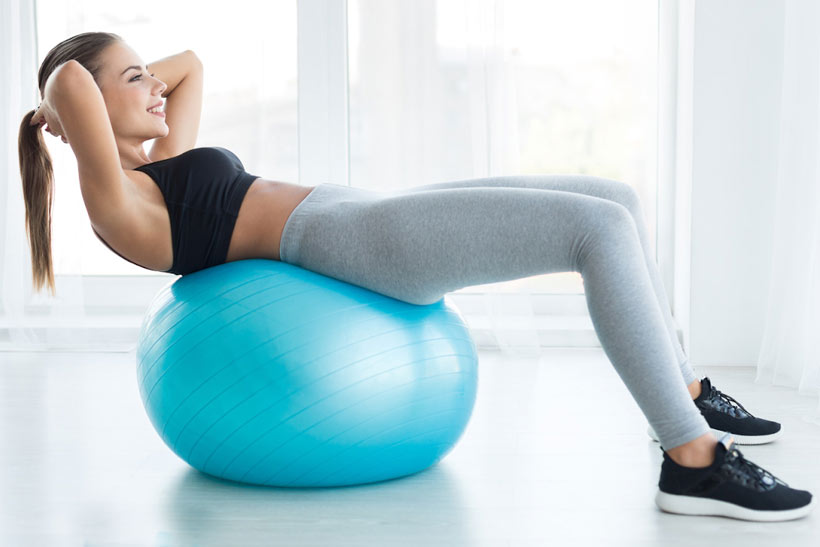 An exercise ball is a must-have in any commercial or home gym. If you’re a newbie, here are exercise ball workouts you can try.
An exercise ball is a must-have in any commercial or home gym. If you’re a newbie, here are exercise ball workouts you can try.
The exercise ball craze that replaced many office chairs over the past decade showed that an orb can burn more calories just by sitting on it.
While it might make work more amusing, the real purpose of fitness orbs is to exercise with them. Yes, they are much more versatile than a bouncing office chair.
And when used properly, you can gain the benefits of a stronger back and abdomen, as well as better overall balance.
Use these exercise ball workouts if you are a beginner. Start by just sitting on the ball to find your center of gravity.
1. Assisted Squats
To get acquainted with your ball, use it as support to do guided squats. Exercise ball exercises like this one helps you with common lower back pain caused by lifting. It can strengthen your thighs, rear, and hips.
- Find an open space against the wall.
- Put the ball between you and the wall close to the bottom of your back.
- Keep your legs hip-width apart and about 1 to 2 feet away from the wall.
- Place your hands on your hips as you slowly squat down and come back up.
- Do not let your knees bend further than your toes.
- Repeat 5-10 times.
Remember that you should not lean into the ball, rather use it as a guide to move smoothly.
2. Bridge Lift
If you are wondering how to use an exercise ball to strengthen your core, but don’t have the balance yet, try the bridge lift. It will help you get used to the ball without trying a major balancing act.
- Use a mat to lie flat on your back with the exercise ball nearby.
- Place your legs on the ball with your calves near the center.
- Put your arms straight at your side with the palms facing the ground.
- Tighten your stomach muscles.
- Use your arms to lift your hips so your rear raises off the floor.
- Hold this position for 10 seconds and release.
You can add a leg lift while holding, alternating legs to get a more difficult workout.
3. Abdominal Ball Raise
You can stay in the same position while moving into a core stomach workout. This is one of those easy exercise ball workouts for beginners since you will be using the ground as balance.
- Continue lying on your back with your legs on top of the ball.
- Move your legs to the sides of the ball as you spread your legs open to hips-width.
- Squeeze the ball between your calves as you tighten your stomach muscles.
- Lift the ball as high as possible without moving the rest of your body. Keep your head on the floor.
- Hold the ball in the air as you take several deep breaths.
- Return the ball to the ground and do 10-15 repetitions.
You can make the exercise more difficult by twisting to either side while holding the ball. Do not let the ball touch the ground and hold the position for a few seconds.
4. Plank
If you’ve ever done a plank then you know how effective it is to strengthen your core. Using exercise balls is an even better way to hold a plank while gaining more balance.
- Begin by lying on the ball on your stomach.
- Place your hands on the floor and slowly walk on your hands forward so that the ball moves down your body to your thighs.
- Your hands should be in line with your shoulders and be kept straight.
- Keep your legs about hip-width apart and straight.
- Tighten your stomach muscles as you take deep breaths.
- Hold the position for several seconds.
- Slide the ball back on your stomach to rest and repeat.
You can enhance this exercise by moving the ball to your shins, creating a more difficult balancing challenge.
5. Leg Lift
Stability ball exercises are an easy way to add some extra weight and support to normal workout routines. Use this leg lift move to keep your legs in sync while enhancing your balancing skills.
- Lie on a mat flat on your back with your legs stretched out.
- Place the ball in between your feet and just touching your ankles.
- Support your neck by clasping your fingers behind your head and lifting slightly.
- Raise the ball using your feet, keeping your legs straight until your legs make a 90-degree angle with your torso.
- Lower the ball, but do not touch the floor. Try to come within a few inches from the ground.
- Do several repetitions, keeping your core tight.
This exercise works your abs, lower back, and thighs, making it a complete workout.
6. Pelvis Circles
Not all ball exercises are for building muscle. Loosening your joints and staying flexible is also important. Your pelvis and hips should stay loose to prevent injury.
- Sit on the ball with your back straight and your head facing forward.
- Keep your arms by your side or your hands on your hips.
- Slowly lean forward and rotate in a circle.
- Complete 3 full circles clockwise then switch to counterclockwise.
You can also do front and back rocking motions or side to side movements to stretch the abdomen.
7. Ab Crunch
The most popular ball exercise is a simple ab crunch. This does take some balance, so sit on the ball and find your center of stability before going right into crunches.
- Sit on the ball with your spine straight.
- Get a firm footing with your feet hip-width apart on the floor.
- Cross your arms over your chest.
- Slowly lower your back as you tighten your stomach.
- Go back as far as you are comfortable.
- Return to the sitting position.
- Do several repetitions.
If your crunches seem too difficult, check the air in your ball. A deflated ball may make this exercise hard to complete.
Gear for Exercise Ball Workouts
Before you start any exercise ball workouts you must find the right gear. Balls come in various sizes and shapes that can help keep your workout interesting. You will also want a mat and comfortable workout clothes and shoes. Check out the fitness equipment section of our blog for reviews and expert workout tips.
Stability Ball Exercises for Beginners
You can use these ball exercises as supplemental exercise in any fitness program. You can also use these exercises as the basis of stability ball workouts.
The Advantage of Exercising on a Stability Ball is That You get More Bang for Your Buck
When performing exercises on the ball, your core muscles and other stabilizer muscles are always active. They are active because the ball is an unstable surface, and in order for it to remain steady, your body must contract hundreds of different muscles to stabilize the ball.
For example, if you are doing push-ups on the stability ball, you are not only working your chest and triceps, but your core, shoulder stabilizers, obliques, and even more muscles are active to stabilize the ball.
This not only means you will make your body stronger and more stable, you will also burn more calories than you would if you did the exercises using a bench or the floor instead of the ball.
What Muscles do the Best Stability Ball Exercises Target?
If you use the stability ball alone, you can target just about every major muscle group. However, stability ball workouts are most effective when using other equipment along with the ball, otherwise, certain muscle groups will be missing out.
Using Stability Ball Exercises Along with Other Equipment Will Help You Target Every Muscle Group in the Body
This is the best option because you can get the benefits of using the ball, while you also get benefits similar to resistance exercise machines.
It is Recommended to Use Stability Ball Exercises to Supplement a Complete Workout Plan
The best function of stability ball exercise is a supplement to a complete full body workout program. Your workout plan should use constantly changing forms of resistance, exercise selection and exercise parameters.
Another good way to use the stability ball for exercise is simply to use it for abdominal and core work only. This means you could perform a mini workout for around 10-15 minutes and use the best core exercises and best abs exercises.
This is something you can squeeze in whenever you have the time. Preferably you could do it as a second exercise session of the day which will increase help your metabolism better than doing a single workout in a day.
What are Some Effective Stability Ball Exercises?
A Good Rule of Thumb for Working out on Stability Balls is “Don’t Get Too Cute”
Choose stability ball exercises which effectively target the desired muscle groups. Start with the most basic and progress from there. Do not get too excited if you see a new exercise which is supposed to very best.
Just the fact that the exercise is new, should be a clue that it is NOT the best. If it is such a great exercise why did it take so long for someone to invent it?
“If it ain’t broke, don’t fix it,” would be an effective strategy. If something works, there is no reason to try to make things “cute,” or more trouble than they are worth. When you get used to the easier exercises it may be time to progress to something more challenging.
Best Stability Ball Exercises Using Nothing Other Than You and the Exercise Ball
Core
Stability Ball Supine Bridge
Start: Take a seat on a stability ball. Sit up tall, with shoulders in good posture (not forward), legs 90 degrees with heels directly below knees.
Begin the motion: Walk forward until your upper shoulders and head rest on the ball. Your legs should be in a 90 degree angle, your glutes should be contracted, and your core drawn in.
It is very important not to arch your back. When you are done, walk back to your original position.
The supine bridge is a position which you use as a starting point for many stability ball exercises with or without weights.
Stability Ball Supine Bridge (1 leg stabilization)
Start: Get in the stability ball supine bridge position. In order for you to be able to stabilize you should put your feet together until they touch.
Begin the motion: Slowly extend one leg off of the ground. That leg should be the ONLY motion which occurs throughout your body. Your thighs should be the same level as you only extend your leg, not flex your hip.
This may look look like an easy stability ball exercises but it is not. Everything else must maintain completely motionless for this stability ball exercise to be performed correctly.
Hold as long as you can maintain the drawn in core and contracted glutes, then switch feet and repeat. If your knee up at all this is hip flexion.
Hip flexion would mean your glutes, which are the antagonist muscle to the hip flexors would not be contracted. Again, your glutes must be contracted for these stability ball exercises.
Stability Ball Russian Twist
Start: Get into the stability ball supine bridge position. It is best to have your feet shoulder width apart. Put both your hands straight up towards the ceiling.
Your hand should be together in the middle of your chest. This is where they should remain during the entire range of motion.
Begin the motion: Put your hands up towards the ceiling. Interlock your hands directly above you chest. Turn to each direction, make sure to keep the feel flat on the floor.
Keep the 90 degree leg angles and arms extended in the middle of your chest.
If you feet move at all, you did not perform the stability ball exercise correctly. Start over and focus on total body stabilization.
Stability Ball Plank (arms on ball)
The plank is one of the best stability ball exercises if you perform it correctly. To perform correctly make sure your core remains drawn in, your back does not arch, and your glutes are contracted.
Start: Place your forearms on the very top of the ball. Bring both of your feet back so your body is in the plank position. Your hips should be close as possible to parallel with the floor. Your shoulders should be directly above your elbows to perform these stability ball exercises correctly.
Hold this position: Make sure to keep your core drawn in and your glutes contracted. Your back must not arch, if it does, you should probably regress to the floor plank until you master it.
Modifications: You can also push your arms forward while you maintain the stable position. Every little bit you push forward, makes this stability ball exercise much more difficult. To increase the difficulty you can also hold on to a stretched bungee cord or surgical tube with your hands. This will make the stability ball plank much more difficult.
Stability Ball Plank (feet on ball)
Start: Lie on the floor and form the plank position. Put your feet on the top of a stability ball. The balls of your feet should be evenly placed on the very top of the ball.
Hold this position: As with every plank exercise, make sure you keep your core drawn in and your glutes tightly contracted while you maintain a neutral alignment with your spine.
Your back should never arch during all stability ball exercises.
Modifications: If this is too difficult, you can decrease the difficulty by placing the ball against the wall. This will allow you to stabilize less.
The harder the stability ball is, the more difficult the stability ball plank will be. To increase stabilization you can take one foot off the ball.
To further increase the difficulty you can abduct the leg, which means bring it out to the side.
Stability Ball Walkouts
Start: Lie on stability ball on your stomach and your hands both on the floor.
Begin the motion: Walk with your hands forward until the only points where you touch the ball are your hands and balls of your feet.
Walk your hands back until the middle of your thighs touch the ball and repeat.
It is very important to maintain a drawn in core for this entire motion. Your lower back should NEVER sag towards the floor.
During the entire motion you MUST NOT feel any pain in your back. If you do, stop immediately and regress to the floor exercises until you master them.
Abdominals
Stability Ball Crunches
Start: Lie face up on the top of the stability ball with your lower back completely supported. Put your hands either across your chest or behind your head.
Begin the motion: Draw in your core, with your glutes contracted. Lift your elbows up towards the ceiling, lower under control and repeat.
To vary the difficulty of this stability ball exercise you can adjust your starting position. The more surface of your back on the ball at the top position the easier the motion.
If your hands are behind your head or you have less surface of your back in contact with the ball at the top position it is a more difficult, longer lever crunch.
Stability Ball Side Crunches
Start: Lie face up with your back on the top of a stability ball. It is best performed if you can put your feet against the bottom corner of a wall.
Turn your body right or left to a 45 degree angle in relation to the ball. You should NOT be directly on your side.
Which ever direction your turn that foot should be forward. Spread your feet apart and put your hands interlocking behind your head.
Begin the motion: Make sure to maintain the 45 degree angle during the duration of the movement. Your elbows should be out to the side away from your body. Lower your body until your lower elbow touches the ball.
Your back should be wrapped around the ball. Raise your top elbow straight up towards the ceiling. Lower slowly and repeat.
Stability Ball Leg Turns
Start: Lie face up on the floor. Put the stability ball between your feet and lift your legs as high above your hips as possible. Put your arms out to each side and make sure each palm is touching the floor.
Begin the motion: Turn your legs down to either side. Keep your feet at hip level the entire range of motion.
Make sure your back does not arch and your core stays drawn in during the entire range of motion.
Your palms should also remain on the floor during the entire range of motion. Your knees should be in line with your toes, not knocked need.
This is one of the best stability ball exercises which isolate your lower abs if you do it properly
Stability Ball Toe Raises
Start: Lie face up on the floor. Put the stability ball between your feet and lift your legs as high above your hips as possible.
Put the ball between your feet or ankles and keep your arms down by your hips.
Begin the motion: Push your heels with the stability ball up towards the ceiling. Your hips should rise off the floor.
Lower your hips back to the floor and repeat.
Modifications: You can also add a twist to either direction to work your obliques.
You can also add ankle weights for added resistance.
Stability Ball V-ups
Start: Lie face up on the floor. Put the stability ball between your ankles and your arms above your head resting on the floor.
Begin the motion: At the same time, lift your arms and feet off the ground until they meet in the middle.
As you reach the top position switch the stability ball from your feet to your hands. The next rep switch the ball back to your feet, or ankles, whichever you can reach.
Modifications: You can also perform the motion without switching the ball from feet to hands. The V-up is one of the best ab exercises as well as one of the best stability ball exercises if performed properly.
If you do not feel fatigue in your abdominal region, it is best to regress to a easier movement.
Chest
Stability Ball Push-ups (hands on ball)
Start: Have the stability ball against a wall. Place your hands on the ball around shoulder distance. It is best if your palms face each other so you can squeeze the ball.
Begin the motion: Slowly lower your chest towards the ball. Push yourself back up to the beginning position and repeat.
Keep your head up, and spine in neutral alignment during the entire duration of the motion. Do not drop your head towards the ball.
Modifications: To progress this stability ball exercise, move the ball away from the wall.
You will have to stabilize more which will make the exercise significantly more difficult.
Stability Ball Push-ups (feet on ball)
Start: Assume a push up position. Your hands should be slightly wider than shoulder distance. Place your feet on a physio ball.
Begin the motion: Lower your chest towards the floor. When your chest is close to the floor or touches, push yourself back up.
Do not let your lower back arch and your hips to sag towards the floor.
You can vary the difficulty this stability ball exercise if you change which part of your leg is resting on the ball.
If your feet or toes are on the ball, it is more difficult. If your thighs are on the ball it is easier.
Walk-out with Push-ups
This stability ball exercise is a combination of the stability ball push-ups with feet on the ball and stability ball walkouts.
The same rules apply. Make sure to keep your core drawn in, your back should never arch.
Dual Stability Ball Bush-ups
Start: Put 2 stability balls against a wall.
They can be spread apart a few inches or touching. Put each hand in the center of each ball.
Begin the motion: Slowly lower you chest towards the balls preferably until you touch your chest to the balls.
Push yourself back up to the original position slowly and repeat.
To increase the difficulty, you can move the balls away from the wall.
This physio ball exercise will require a lot of shoulder stabilization.
Dual Stability Ball Chest Flies
Start: Have 2 stability balls on the floor spread about 10 inches apart. Place each forearm about 1/4 from the center into each ball. Bring your feet back to a push-up position.
Begin the motion: Slowly lower your body by spreading your arms apart until they are directly at your side. Once you are in the bottom position, hold for a second, feel the stretch in your chest.
Squeeze your forearms back together. The balls should follow and you should end up in the original position.
This is one of the most advanced stability ball exercises so do not expect to be able to do it if you are a beginner.
Legs
Stability Ball Squats
Start: Place a stability ball against a wall. Lean back into the ball with it positioned in the middle of your back. Position your feet around shoulder distance apart.
You should have your feet about a foot in front of your hips.
Begin the motion: Draw in your core and slowly drop your hips straight down towards the floor.
Stop when your hips, knees, and ankles are aligned in a 90 degree angle. Pause for a second and squat back up to the original position.
This exercise is one of the most versatile stability ball exercises which you can modify many different ways. Stop if you ever experience knee or lower back pain.
Stability Ball Hip Extensions
Start: Form the supine bridge position. Make sure your knees are directly above your ankles.
Begin the motion: Draw in your core and lower your hips towards the floor until your butt touches the floor. Slowly extend your hips back up to the original supine bridge position. At the top position, your lower back should not be arched.
Make sure to contract your glutes. Your knees must remain directly above your ankles for the entire motion. Your should never lose the drawn in core also.
Modifications: To increase the difficulty you can put your feet on an unstable surface such as a BOSU ball or balance disk. To increase the resistance you can either have a weight across your hips.
Stability Ball Hamstring Curls
Start: Lie floor with your hands by your side. Place the stability ball under your heels with your legs fully extended. Your butt should be touching the floor. This exercise is one in which the softer the stability ball the better.
Begin the motion: Draw in your core. As you pull the ball towards your body with your heels you should raise your hips in one continuous motion. Make sure to contract your glutes.
The top of the motion your hips should be as high as possible without arching your back. In one continuous motion, lower yourself back to the original position. You also have the option to plantar flex (push your toes in ball for calf raise) your toes into the ball.
Modifications: Change hand positions and / or use 1 foot at a time to increase the difficulty of the stability ball hamstring curl. This increases difficulty for these stability ball exercises because more stabilization or strength is needed.
Stability Ball Twisting Lunges
Start: Hold a stability ball in between your hands from a standing position.
Begin the motion: Lunge forward. Make sure when you lunge forward, your plant your front heel. Your knee should be directly above your heel. Your back knee should be about 1 inch above the floor. With your arms outstretched directly in front of you turn the ball towards the leg which is forward until it passes over the knee. Only turn as far as you can with your core drawn in tightly.
To increase the difficulty you can simply perform a stationary lunge or 2 or 4 or 10 in between each step. Lunges are great stability ball exercises but can also be used with other exercise balls.
Lower Back
Stability Ball Back Crunch
Start: Lie your chest on top of a stability ball. Your feet should be fully extended behind you. Put your hands behind your head.
Begin the motion: Slowly extend your shoulders up towards the ceiling. Make sure you maintain a drawn in core.
This exercise is not for everyone. Consult with your trainer to see if you should be doing it.
The stability ball back crunch directly exercises the erector spinae (low back muscles) while all stability ball exercises indirectly work the core to support the lower back.
Stability Ball Cobra
Start: The same position as the stability ball back crunch (above).
Begin the motion: Slowly extend your arms out fully in front of you with your thumbs up. Keep your arms as high as they can towards the ceiling and slowly rotate your arms all the way around in almost a full circle until your arms are close to your hips.
Slowly bring your arms back the opposite direction until they are in the original position then repeat.
Keep your thumbs up towards the ceiling for the duration of this movement.
Stability ball cobra is one of the stability ball exercises which can also be performed on the floor or BOSU balls.
Here is More information related to the Best Exercises
- Buy Only the Best Exercise Balls
The Duraball Pro is the best stability on the market and with proper care will last you years. As mentioned before, it allows you to use hundreds of pounds, NEVER gets lopsided and looks good in any gym. - Stability Ball Exercise Videos
Enter the exercise video library and watch free stability ball exercises on video categorized by body part. See dozens of exercises videos of stability ball exercises. - Stability Ball Workouts
If you want to use Swiss balls exclusively in your exercise program learn from a personal trainer the pros and cons to stability ball workouts. - Best Back Exercises
The lats (upper back) is the only weakness of stability ball exercises. You cannot exercise your lats with just a stability ball. Find exercises which are the most effective for working the muscles which will give you the desired v shape. - Best Legs Exercises
Weight training for your legs is very important because they contain a high percentage of your total body’s muscle mass. Find the most effective exercises for your legs. Stability ball exercises for your legs are not as difficult as the best legs exercises. - Best Arms Exercise
Whether you are looking to tone your triceps or build bigger biceps, the best arm exercises will cut your training time and improve your training results. The arms are hard to target with stability ball exercises alone, but if you add dumbbells and barbells you can get a complete workout. - Best Chest Exercises
The muscle group that involves the best chest exercises is important for men and women. It is important because it is a large muscle group which will have a significant impact on your metabolism if included in your exercise program.
Stability Ball Workout Tips
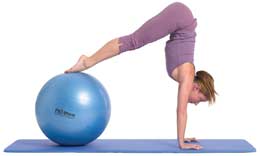
Stability ball workouts are an entire exercise session on a stability ball. A stability ball or Swiss ball is considered the best exercise ball by some. People who have never used stability balls before may be skeptical to the idea that you can get a good workout with just a Swiss ball.
These people would most likely be experienced “old school” weight lifters who have the mindset that if their not using triple digit weighing steel weights the workouts are not effective. Stability ball exercises have a place in any exercise program and a good stability ball workout can be performed at home, in the gym or even outdoors.
A workout is a full exercise or training session is a certain amount of time. During the time you workout, your exercise selection should be determined by which exercises are best for achieving your fitness goals.
The Best Stability Ball Workouts are Going to be Effective
If stability ball workouts are going to be effective for you, you should write down your specific goals. In order to determine the most effective workout for your time you must have a reason for working out in the first place. Goal setting is very important as it will eliminate wasted time due to performing an ineffective exercise selection.
If your goal is to lose a very small amount of weight (tone up), strengthen your muscles slightly, strengthen your stabilizers or strengthen your abdominals and core, then stability ball workouts may be all you need. If you have significant goals such as gaining 20 pounds of muscle, losing 20 pounds of fat, becoming a powerlifter or just increasing your strength dramatically, a stability ball alone will not do it.
A Stability Ball can be an Integral Part of Any Workout
Stability balls are versatile and can be used by themselves for a total stability ball workout or they can be used in conjunction with other pieces of equipment or body weight exercises which require no other equipment other than the Swiss ball and your willingness to perform exercises on it. Click here for some of the best stability balls.
There are 3 Types of Stability Ball Workouts
Stability Ball Only
If you want to perform an entire workout with exercises which involve the stability ball for whatever reason, you can do so. You can also use multiple stability balls for some exercises.
There are stability ball exercises for most of your body’s muscle groups. You can perform groups supersets which is doing 2 exercises back-to-back with no rest in between for one set.
Performing supersets and even larger sets with little or no rest are easy to perform with the stability ball. Since every exercise is being performed on the ball, you never have very far to go so you have little excuse for rest.
If workouts with just the stability ball are designed properly, you will not have to stop to rest very often because you will be working opposing muscle groups. “Supersetting” opposing muscle groups together allows you to recover one body part while you exercise the other.
Stability Ball & Body Weight Exercises Only
An example of an exercise set which uses body weight exercises along with stability ball exercises is on the right. Stability ball crunches and rotating down to the floor for push-ups is a great way to work your chest, abdominals and transverse abdominis (core) at the same time.
If you do not have access to any other equipment and want a great workout you can create one on a stability ball which involves body weight exercises off of the ball.
Since you are using your body weight as resistance with stability ball exercises, it makes little sense to limit yourself to exercises on the ball.
Stability balls are great, but during some situations in your workout a body weight only movement may be the best exercise to use.
You can also superset a stability ball exercise with a floor exercise which works the same body part.
For example, push-ups on the stability ball or 2 stability balls are far more difficult than push-ups on the floor.
To work your chest muscle group very hard you can perform a set of stability ball push-ups to failure and immediately transition into floor push-ups until you cannot perform another rep with good form.
Stability Ball & Gym Equipment
An example of part of a stability ball workout in the gym or at home would be the dumbbell stability ball chest press (right).
It is a great exercise because it helps build stabilization strength as well as work additional muscles such as the core, glutes and quads while concurrently working the target muscle group.
Workouts in the gym or your home gym with other equipment are tremendous. You may be bored with your current workout or simply want to experience the benefit of stability balls.
Workouts with a Stability ball along with dumbbells, barbells, cables, tubes and any equipment which is available to you can be some of the most effective and fun workouts you could do.
This holds true for athletes, bodybuilders, novices, beginners and expert personal trainers.
Any exercise which can be performed on a weight bench, can also be performed on a stability ball. With knowledge and imagination you can create a great the best workout for your specific goals by utilizing the stability ball along with a variety of gym equipment.
What are some Good Stability Ball Workouts?
For more information about workouts and custom workout programs for your specific goals check out the Workout Routines page.
The Secret to Getting Effective Core, Abdominal & Stability Ball Workouts
- Best Core Exercises
It is important you know the anatomy of the core and have strong enough base core strength before you perform stability ball workouts. - Stability Ball Workouts
Learn some stability ball exercises for the entire body. Learn more about why a stability ball may be your best friend when it comes to accomplishing your fitness goals whether you use stability ball workouts or not. - Resistance Training for the Entire Body
Click on the anatomy guy and find exercises and the detailed anatomy, physiology and kinesiology background.
Medicine Ball Exercises for Beginners
Introduction
When you think of medicine ball workouts you may think of the heavyweight champ getting a medicine ball slammed into his abdominal region. While this is one way to train with a medicine ball, there are many other medicine ball exercises.
You can Use Medicine Balls to achieve a Variety of Health and Fitness Goals
Medicine ball exercises can help you train for explosive power, strength, and stabilization, and they can help you balance your entire body.
Medicine balls are additionally versatile enough that you can use them by themselves for dynamic medicine ball workouts or along with other classic forms of resistance training such as free weights, body weight, or cable exercises.
Why Medicine Ball Workouts?
Medicine Balls Provide you with a Round Surface
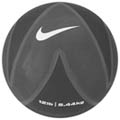
Since a medicine ball provides a round surface, you can use it as an unstable surface to increase efficiency.
The same principle for working your core muscles works with medicine balls.
When you perform medicine ball workouts you train your stabilizers along with the prime movers. The prime movers are the primary muscles, those which are supped to perform the action.
Strengthening your stabilizers will help you perform all weight training exercises such as bench press and squats more efficiently.
Medicine Balls provide Significant Resistance
You can get medicine balls which weigh up to 30 pounds or more. Even if 30 pounds sounds light to you it will not seem light at the end of a tough medicine ball workout. Medicine ball exercises are a great way to supplement other weight training exercises during an intense scientific personal training program.
Medicine Balls Take up very little Space
Even the heaviest medicine balls don’t take up very much space. Unlike a stability ball which is filled with air, medicine balls are usually made of thick rubber or are filled with sand.
Since they are very dense a medicine ball with a significant resistance can take up very little space. You can have a set of medicine balls in your hallway closet. There are medicine balls which are made large for different purposes.
Medicine Balls are Very Durable
Medicine balls allow you to perform exercises in rough conditions. All you have is a brick wall in your backyard? Throw a medicine ball into it from different angles for a few minutes. The brick wall will take a beating but the medicine ball will remain the same.
Medicine Balls are Soft Enough

Most medicine balls are not as hard as rocks. They are even hard enough to allow you to perform the exercises you see boxers and fighters doing when they throw the balls into each others stomach.
Since you probably have no desire to be a boxer you the softness of the medicine balls allows you to perform catching exercises.
Exercises in which you catch the ball have different benefits. When you catch the medicine ball from any position your body has to activate different muscles. If you are in a position where you have to balance and catch the ball, the medicine ball workouts will help improve your balance.
Medicine Ball Workouts for Two
Medicine ball workouts are a great way to work out in pairs. Since medicine balls are heavy you can share the load for fun workouts where you and your workout partner get some work.
What are some Medicine Ball Exercises For All Body Parts?
These medicine ball exercises are great to throw in during your weight training workouts to change it up. You can also use them al together as a medicine ball workout which will be challenging for your core, cardio and muscles.
Warm Up
After your general cardio warm up you can perform a little more dynamic warm up with a medicine ball. You can even use this medicine ball exercise if you haven’t performed a general warm up because it dynamically uses your major muscle groups.
Step up with Medicine Ball Twist
Start: Have a step at a desired height. The higher the step the more this medicine ball exercise will work your legs and glutes.
The step should not be too high to where you struggle to reach it. Make sure the surface is stable and flat. Hold a medicine ball with both hands against your chest.
Begin the motion: Step up onto the step with one foot. Lift the opposite knee as you step up to assume a position balanced on one foot.
As you lift your opposite knee up, extend your arms and rotate your torso and the medicine ball across the knee which is raised.
Be careful as you lower yourself back to the original position at the bottom of the step and repeat with the other leg alternating.
Modifications: You can perform a given number of reps with one leg at a time or you can perform this exercise as your medicine ball workout all together.
To increase the difficulty you can use a heavier medicine ball or increase the height of the step. You can use this as the first exercise in all medicine ball workouts or you can use it as a legs or cardio exercise.
Core / Abs
Medicine balls are very effective for working your core and abs.
Before you perform any medicine ball workouts, make sure you have mastered the best core exercises and you know the difference between core and abs.
Medicine Ball Sit Ups
Medicine ball sit-ups are a good way to develop functional strength for your mid section. You will use your hip flexors also, but that is part of functional movement because it mimics activities of daily living.
These medicine ball sit-ups are a great way to work your chest, arms and shoulders while your work your abs. You can perform alone or with a partner who will throw the ball at you and catch it.
Start: Sit flat on the floor with your legs bent to around a 90 degree angle. Keep your feet flat on the floor for the duration of this motion.
Begin the motion: Sit up without the ball and catch it when it is thrown to you.
Lower the medicine ball to your chest as your lower your upper body towards the floor.
After your back touches the floor sit back up and push the medicine ball up towards the ceiling and throw it at your workout partner or up in the air and catch and repeat. Medicine ball workouts are not complete without some throwing which can increase your power as well as keep your heart rate up.
Medicine Ball Twists
Medicine ball seated twists are a great way to work your abs, hip flexors, core, and obliques.
Start: Sit on the floor and lift your feet off of the floor. Swing the medicine ball up and hold it. Your feet will remain off of the floor for the duration of this exercise.
Begin the motion: Turn the medicine ball towards one side and touch the floor with it.
Once you touch one side, immediately turn the ball over to touch the other side of the floor. Remember to keep your core drawn in for the duration of the motion.
Modifications: You can bounce the medicine ball on each side if you want. Another great modification is to throw the medicine ball up to yourself after you touch the floor on each side.
You may find it difficult to keep your feet up for the duration of the motion. Certain body types with long or heavy legs will find this exercise more of a hip flexor exercise. If this is the case you may want to avoid this medicine ball exercise. Remember medicine bal workouts are flexible so don’t get discouraged if you some medicine ball exercises are not for you.![]()
Legs & Glutes
If you use medicine balls while performing body weight leg exercises you will work the muscles which stabilize your body more.
Lunge w/ Torso Twist
This medicine ball exercise is a must for all medicine ball workouts.
Lunges with twist are a tremendous exercise to work your legs, glutes, obliques, core and overall stabilization. The twisting motion of your upper body will challenge your lower body’s stabilization.
Start: You can either perform these walking provided you have enough free floor space or stationary if space is limited.
Take a medicine ball and hold it at your chest. Stand up tall with your core drawn in and your shoulders in neutral alignment.
Begin the motion: Lunge one foot forward and land with your heel or the back 2/3 of your foot first. Your lunge should be far enough to where your knee is directly above your ankle and your front and back legs are close to a 90 degree angle.
From the bottom position with your back knee about an inch off of the floor extend your arms with the medicine ball. Keep your core tight and rotate your upper body and the medicine ball over the front leg as far as you can while you maintain your drawn in core.
Modifications: You can perform multiple stationary lunges for each lunge or multiple twists each time you lunge for a more intense workout. This is a good exercise to use at the beginning, middle and end of your medicine ball workouts.
Chest
Medicine balls can make the push up, one of the most basic leg exercises advanced by adding a shoulder stabilization component to it.
Medicine Ball Alternating Push-ups
Medicine ball alternating push-ups are a great way to exercise your shoulder stabilization as well as your chest, anterior deltoids, triceps and core.
Start: Have a single medicine ball on a hard surface. Place one hand on the ball and one hand on the floor. Your hands should be spread apart significantly wider than shoulder width
Bring your feet back so your are in the plank / push-up position with a neutral back.
Begin the motion: Keep your body and spine in neutral alignment. Lower your chest towards the floor.
Since the surface is uneven you will be able to lower the side with your hand on the floor lower than the side with the medicine ball.
Push your self back up to the original position. Roll the ball to the other side while you keep your hips from tilting to work your core. Repeat the push-up while you keep your tight drawn in core with your head and spine in neutral alignment.
Modifications: The closer your feet are towards each other, the more difficult this exercise will be for your core. You can perform a number of reps with your hand on the ball and then switch to the other side or you can perform a single push-up on at a time.
If you lift a foot up or place your feet on an unstable surface such as a BOSU ball you will increase the need for stabilization and make the exercise more difficult.
Triceps
The triceps are a synergist (helper muscle) for most chest and shoulder exercises.
If you perform any chest exercises during your medicine ball workouts there is a good chance you have already worked the triceps.
Medicine Ball Triceps Push-ups
Close grip pushups with both hands on a single medicine ball are not only one of the best functional exercises, but one of the best exercises for triceps.
Start: Have a medium or large sized medicine ball and place it on a flat hard surface such as the gym’s rubberized flooring or a hardwood floor. Place both your hands on the medicine ball.
It works best if your palms are facing each other towards the side of the ball. Push yourself up until you are in a solid push-up position with your spine in neutral alignment.
Begin the motion: Keep your head up with your elbows close to your sides and lower your chest all the way to the medicine ball.
As you lower yourself down make sure you keep your core tight and don’t let your hips sag towards the floor.
Modifications: If you cannot perform these push-ups from your feet you can perform them from your knees. If you perform push-ups from your knees start from your feet. Drop your knees straight down towards the floor and keep your back in the same alignment. You can also perform the following medicine ball press for chest and triceps.
Medicine Ball Triceps Press
If you are not able to perform push-ups on a single medicine ball you can perform the close grip triceps press.
Start: Lie on either a bench or get into the supine bridge position on a stability ball. If you use the stability ball, make sure your head and upper shoulders are rested on top of the ball.
Your legs should be in a 90 degree angle with your knees directly above your ankles. Hold the medicine ball tight with both hands on the side of the ball.
Begin the motion: Keep your elbows in towards your sides as you lower the medicine ball towards your chest. You should contract your triceps while you lower the ball.
Once you touch your lower chest with the medicine ball raise it up squeezing your triceps.
Modifications: If you perform these when you are not already fatigued the resistance of the medicine ball may not be enough. If you have a workout partner you can have them apply manual resistance to the ball by pushing down on it.
 Lats
Lats
The lats are really the only body part which exercise balls cannot exercise very much. You can use other equipment along with medicine balls to really get the lats but you can work your lats on days you don’t do medicine ball workouts.
Medicine Ball Pull-Overs
Medicine ball pull-overs are a great exercise to stretch your chest and the long head of your triceps as well as work your lats.
Start: Lie on a bench or you can be in the supine bridge position on a stability ball. Hold a medicine ball on the sides.
Holding the ball on the sides will allow you to keep your elbows in towards each other which will increase the effectiveness of this medicine ball exercise and prevent a shoulder injury.
Begin the motion: Keep a slightly bent position of your arms and lower the medicine ball behind your head.
It is important you take a deep breath as you lower the medicine ball because it will allow your rib cage to naturally expand.
Squeeze your chest and triceps as you bring the ball back to the original position above your chest.
Modifications: Since a medicine ball is probably a lighter weight than you are capable of lifting you can super-set this or perform it after a serious of any other medicine ball exercises for your upper body. This will create a complete medicine ball workout.
More Articles about Various Resistance Training and Ball Exercises
- Medicine Ball Exercise Videos
View dozens more medicine ball exercise videos. - Best Exercise Ball
Looking to work out at home? Find the best exercise balls including the best med balls for great medicine ball workouts and buy the best med balls. - Stability Ball Workouts
You can get a great workout for your entire body with a stability ball. You can even perform some Swiss balls exercises with medicine balls. - BOSU Ball Workouts
BOSU balls are amazing. Once you perform some exercises on them they will become indispensable for your exercise program. - Resistance Exercise Information Articles
Medicine Ball Workouts Tips
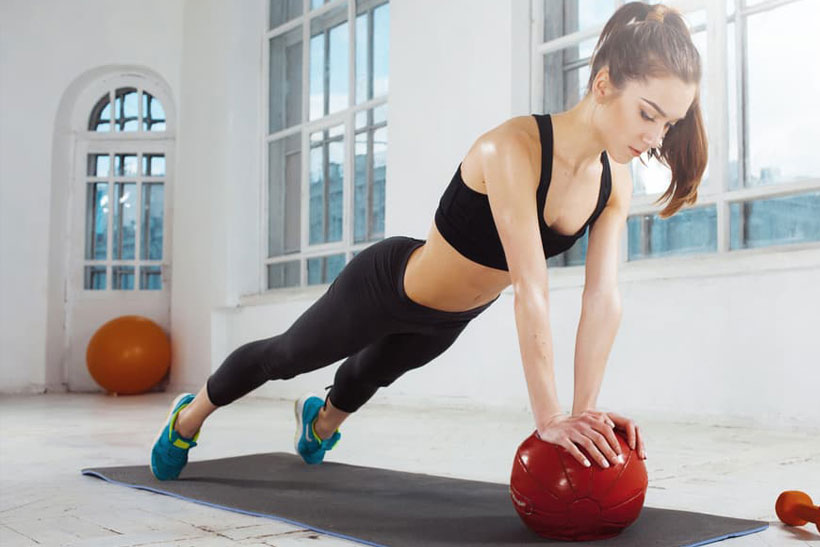 While the conventional way to get your body in shape involving cardio and weightlifting is still pretty much dominant, many new ways of training have emerged and are well-received.
While the conventional way to get your body in shape involving cardio and weightlifting is still pretty much dominant, many new ways of training have emerged and are well-received.
Functional fitness, for example, is one of the rising stars. Exercises inspired by functional fitness help your muscles get ready for daily stimulation.
You can’t tap into functional fitness training without using medicine balls.
Below is everything you need to know about this lovely piece of workout equipment and the best exercises to use them.
What again are medicine balls?
 Medicine balls, also known as fitness ball, is roughly 13.7 inches in diameter. These shoulder-length balls were used in rehabilitation to help physically dysfunctional patients to recover.
Medicine balls, also known as fitness ball, is roughly 13.7 inches in diameter. These shoulder-length balls were used in rehabilitation to help physically dysfunctional patients to recover.
In sports medicine, these balls significantly improve muscle strength and neuromuscular management.
Nowadays, medicine balls are used in gym and workout centers as well. These weighted products promise to intensify muscle workout.
The great thing is you can use medicine balls in any exercise to challenge your body to the core.
Why You Should Choose Medicine Balls
Medicine balls are a better choice for your health for many reasons. Instead of buying an expensive gym membership, you can always start with simple yet effective exercises with medical balls.
Here are some of the advantages of using medicine balls
- These products come with different weights and size, offering many different exercises.
- They are compatible with ANY exercise and movement you can think of, from a static one to lie down.
- Unlike dumb-bells, they are not likely to damage your floor if you accidentally drop them.
- They increase your balance, muscles strength and stability without compromising fun and enjoyment.
- Little to no chance of getting injured.
- Your joints are safe with medicine balls.
Adding medicine balls brings a whole new excitement to your workouts. Medicine balls also come with different shapes and sizes, so that you can certainly pick one suitable for your need.
How to Choose Medicine Balls
For beginners, you will need a small medicine ball from 2 lbs. Once you get used to the ball and exercises, then you can upgrade your ball to 10 lbs or more. It is essential to keep up with regular increments so that your muscles are strengthened continuously.
Below are some of my recommendations!
- AmazonBasics Medicine Ball (Bounceable)
- Valeo Medicine Ball (Hardshell)
- SPRI Dual Grip Xerball (With handle)
- AeromatDula Grip Power Medicine Ball (With handle)
For more information, please follow: https://www.easysportslife.com/best-medicine-balls
Be flexible when it comes to the weight of medicine balls. As I said, you can always start with the minimum weight and then increase it once you feel ready.
How to Work Out with Medicine Balls
First thing first, you will need a big enough space and 10 minutes to start.
Exercising with medicine balls is quite simple because you can always start with simple aerobic/ anaerobic training.
More importantly, when exercising with medicine balls, you shouldn’t do the workouts with rest. One minute break between exercises allows your body to rest and get used with the workout rhythm.
Five Great Medicine Ball Exercises for You to Try at Home
If you have already tried to toss the ball back and forth, here are some more inspirations for you to get your body moving.
#1. Squats
Squats, the ultimate remedy for strong and sculpted butts, are the excellent start.
The classic squat involves spreading your feet till they reach shoulder-width apart, then lowering your hips downwards and at the same time bending your knees.
You need to make sure that you feel all the muscles behind your butts and thighs. With medicine balls, once you bend your knees, raise the ball over your head.
You can try medicine balls with different varieties of squats, such as squat and lunge, side-to-side squat jump and plie squat.
#2. Sit-ups
The second piece-of-cake exercise I want to recommend is sit-ups. The exercise is simple. Lay flat on the floor with both feet and back touch the ground. Use your hands to hold the balls in front of your chest.
Now you just need to do some sit-ups while holding the ball. The weight will engage your muscles even more.
#3. Toe touch
Lie with your back and then put your legs up in the air. Make sure that your legs are perpendicular to the ground. Put the medicine ball above your head; hold it while your arms extend. Life your whole body, including arms and torso so that the ball can reach your toes.
You are not allowed to move your legs. This exercise helps to improve your core so that you should try to reach as far as possible.
#4. Mountain climber
As the name suggests, mountain climber resembles the movement when you climb up. If you climb the mountain regularly, you will see the benefit of this exercise instantly.
The position is similar to a close plank position with both your arms and legs extended. Keep the pose and then pull your knee up to your chest (you can choose right or left). Make sure that the other leg is straight.
Continue to change the knees and keep breathing during the process. You can always add the medicine balls to the process.
#5. Push-up
You can use a medicine ball on simple push-ups. Get to the push-up position and place your hands on the medicine ball. Typical push-ups focus on your chest and upper arms, but with an added medicine ball the whole upper core is engaged as well.
If you feel too tired, you can let your knees loose by placing it on the floor.
The Bottom Line
Medicine balls are indeed the alternative for home-based training and core workouts. These items are useful tools to share with your partner as well.
For those who start with medicine balls, I believe that this article has everything you need, from the definition to the usage. If you have been using these products for a while and are up for a change, consult your trainer for more exercises and a physician in case you have any questions.
BOSU Ball Exercises for Beginners
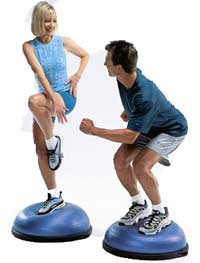
The BOSU balance trainer is a very versatile tool. It is great to use for balance, core, and abdominal exercises, but you can also use it for a full-body workout.
If you want to get a good workout from a single, affordable piece of equipment that does not take up too much space, you should consider the BOSU balance trainer.
The BOSU balance trainer is one of the best exercise balls. The BOSU balance trainer allows you to perform balance, strength, and power exercises.
No Other Exercise Ball Has the Versatility of the BOSU!
Benefits of BOSU Ball Exercises
The BOSU Can be Used at All Different Activity Levels
The BOSU is great for beginners, experienced fitness enthusiasts, athletes, bodybuilders, and anyone who wants challenging and fun exercises. If you are a beginner, most BOSU ball exercises are easy to learn. You can get a great BOSU ball workout with just the BOSU or you can use the BOSU along with other equipment.
If you use the BOSU with other equipment, you can challenge your balance while your perform resistance exercises. You can also use the other equipment to increase the difficulty of the BOSU ball exercises.
Why Use BOSU Ball Exercises Rather than Stability Ball Exercises?
To Compare the BOSU Ball to the Stability Ball is Like Comparing a Truck and a Car
Trucks and cars perform the same basic function: drive you around. Yet there are functions which a car can do that and a truck cannot, and vice versa. There is no reason to say that BOSU ball exercises are better than stability ball balance training exercises or that stability balls are better. You should incorporate both into your workout regimen. This will ensure you receive the benefits of both while developing a fun, interesting exercise program.
What Are Some Effective BOSU Ball Exercises?
Use BOSU Ball Exercises to Complement a Full-Body Complete Exercise Program
As with most exercise balls, it is best to use the BOSU as a complementary tool. Use the BOSU to progress floor exercises. As with any exercise progression, make sure you are solid on the basics before attempting to progress. In this case, you should master the floor exercise before you attempt the BOSU ball exercise.
Here are Some of the Best BOSU Ball Exercises Which Require No Extra Equipment
BOSU Exercises for the Core
BOSU Ball Supine Bridge
Start: Lie on the floor with the BOSU ball at your feet. Place your feet on the top of the BOSU ball. Your knees should be directly above your ankles. The round side of the BOSU can be facing up, or you can have the ball upside down. To have the ball upside down makes the exercise more difficult.
Begin the motion: Draw in your core as you lift your hips up towards the ceiling. Make sure not to arch your back at any point of the motion. The goal with this movement is to use your glutes primarily, not your hamstrings or lower back.
You can either perform a static hold or as a dynamic exercise. To perform a static floor bridge, squeeze your butt and hold at the top position for several seconds before lowering back down. To perform a dynamic floor bridge, slowly lift and lower your hips as described above for a set of your desired number of repetitions.
BOSU Ball Plank
The plank is one of the best BOSU ball exercises if you perform it correctly.
Start: Place your forearms on the very top of the ball. Bring both of your feet back so your body is in the plank position. Alternatively, you can have your forearms on the floor and feet on the BOSU.
Hold this position: Make sure to keep your core drawn in and your glutes contracted. Your back must not arch, if it does, you should regress to the floor plank until you master perfect floor plank form.
Begin the motion: Once you have mastered the BOSU plank you can progress to increase the difficulty. Some of the progressions to the BOSU ball plank include:
- Hip Extension- Keep your core drawn. Make sure your back does not arch. Slowly lift a foot off of the ground and hold.
- Leg Abduction- Same set up as above, but when you lift your leg, slowly move it away from your body. Make sure your toe points straight down towards the floor.
- 1 Arm Plank- Slowly take one arm off of the ball and hold the position.
- 2 BOSU Ball Plank- Either place one arm on each BOSU or your arms on one BOSU and your feet on the other.
- Upside Down BOSU Plank- Perform the plank on the BOSU ball with your arms on the flat part of the ball while the ball is upside down.
- Combination- Combine any 2 of the above.
BOSU Ball Side Plank
Start: Lie on your side and place one arm and forearm on the top of the round part of the BOSU. Have your body completely outstretched and place your feet on top of each other or next to each other.
Hold this position: Lift your hips up until your spine is aligned. Hold this position. Alternatively, you can perform the dynamic side plank. Lower your hips until they touch the floor, then raise them back to the original position, repeating for your desired number of reps.
BOSU Exercises for the Abdominals
BOSU Ball Exercises for the Abdominals are Some of the Most Effective Abs Exercises
This is because the round and semi-stable surface of the BOSU allows your back to bend around it. This means you will get more range of motion for crunches which equals more work and most likely better results.
BOSU Ball Crunches
Out of all BOSU ball exercises, crunches provide the most benefit when using the BOSU.
Start: Lie face up on the top of the BOSU ball with your lower back completely supported. If you put your butt below and almost off the BOSU you will be in a good position for a beginner. Put your hands either across your chest or behind your head.
Begin the motion: Draw in your core.Using your abdominal muscles, lift your chest and elbows up towards the ceiling, lower under control, and repeat.
Modifications: To vary the difficulty of these BOSU ball exercises, you can adjust your starting position. If you move back to where your butt is on top of the ball, you must lift more of your upper body weight. This will make the exercise more difficult. If your hands are behind your head, the weight of your arms will also help make the BOSU ball crunch more difficult.
If at any point during this BOSU ball exercise, you feel pain in your lower back, stop and rest before trying again. If the pain persists, you should regress to an easier exercise.
BOSU Ball Multi-Crunches
Start: Same as above.
Begin the motion: You can perform twisting crunches on the BOSU as well as many other exercises. Twisting crunches resemble the ab bicycle.
Modifications: As you perform a crunch with your hands behind your head, lift one knee up in the air as you turn your opposite elbow toward the knee. Lower your upper body and leg slowly back to the original position and alternate.
There are so many different varieties of BOSU ball crunches that it’s impossible to cover them all here. Please watch the videos of BOSU ball exercises to get some more ideas.
BOSU Ball Leg Scissors
Start: Lie the round part of the BOSU with your lower back completely supported. Both arms should be touching the BOSU to help balance you on the ball.
Begin the motion: Keep your core drawn in and lift your legs off the ground. Lift your legs as low as possible off of the ground. If your lower back arches, lift them higher.
Keep your legs either completely straight or slightly bent with no movement at the knees for the entire motion. Alternatively lift and lower your legs up and down in a scissor-like motion.
You can also go side to side. Abduct your legs at the same time out to the side. Adduct them together and overlap when they meet. Alternate which side overlaps each time.
This is one of the best BOSU ball exercises for your lower abs if performed correctly. Stop immediately if you feel pain in your lower back. Make sure you keep your core drawn in at all times.
BOSU Ball V-ups
Start: Lie face up on the BOSU. Make sure your lower back is supported by the BOSU. Draw in your core.
Begin the motion: Lift your arms and feet off the BOSU at the same time until they meet in the middle. Hold this position.
Modifications: You can also slowly lower your arms and legs at the same time and repeat. If you can do this dynamic BOSU ball exercise you are are on the right path to master BOSU ball exercises.
BOSU Exercises for the Chest
BOSU Ball Push-ups
Start: Place your hands on the BOSU about shoulder width apart. It is best if your palms face each other so you can squeeze the ball.
Begin the motion: Slowly lower your chest towards the ball, keeping your body straight as a plank by engaging your core. Push yourself back up to the beginning position and repeat. Keep your head up and your spine in neutral alignment during the entire duration of the motion. Do not drop your head toward the BOSU.
Modifications: You can also perform push-ups with your hands on the flat side of the BOSU, or with your feet on either side of the ball and your hands on the floor. Push-ups are one of the most modifiable BOSU ball exercises.
BOSU Dynamic Hands Plank
Start: Begin from the plank position with your forearms on the round part of the BOSU.
Begin the motion: Push one hand into the ball and push yourself up until you are in the push-up position. Place one forearm onto the ball and lower yourself back into the plank position. Alternate arms as you repeat.
Modifications: You can also perform these BOSU ball exercises with 2 BOSU balls. Put your feet on either side of a BOSU and your hands on the round side of the other BOSU. You can also perform this with a separate BOSU ball for each hand.
To progress this exercise further, you can add a push-up or 2, or 3 every time you push out of the plank to the top push-up position. These are all great BOSU ball exercises for your chest and shoulder muscles.
1 Hand on BOSU Push-ups
Start: Assume the push-up position. Position a single BOSU to one side. Put one hand on the BOSU and the other hand on the floor.
Begin the motion: Slowly lower your chest towards the floor and push yourself back up. Keep your head and spine in neutral alignment. Never drop your head during any part of this movement. Your butt should not rise, and most importantly, your back should never arch.
Modifications: You can perform a certain number of repetitions on one side and move the ball to the other hand for the same number of reps. You can also alternate which hand you put on the BOSU for each rep.
Dual BOSU Ball Push-ups
Start: Place 2 BOSU balls next to each other. Put each hand in the center of each ball. Bring your feet back until your body is fully outstretched.
Begin the motion: Slowly lower your chest towards the balls, preferably until you touch your chest to the balls. Push yourself back up to the original position slowly and repeat.
Explosive Plyometric BOSU Ball Clapping Push-ups
Start: Same as above.
Begin the motion: Lower your chest down to the ball and explosively push yourself off the BOSU balls as high as you can. As soon as you leave the ball clap your hands. Land in one smooth motion and repeat.
BOSU Exercises for the Legs
If you have been trying to decide whether or not to buy a BOSU ball, get ready to learn the most important reason to do so. The legs exercises possible on a BOSU are what makes the BOSU one of the best fitness buys for anyone.
With the BOSU, you can perform the complete variety types of leg exercises, improving strength, power, endurance, flexibility, cardio, and balance.
BOSU Ball Squats
Start: You should always start by standing on the round side of the BOSU. Stand with feet shoulder width apart. Keep your core drawn in. You are only ready to begin when you can balance on the BOSU. You can extend your arms in front of you or to the side for balance if you want.
Begin the motion: Slowly squat down. You can squat all the way until your butt touches your calves if you have healthy knees. Slowly stand back up to the balanced position and repeat.
Squats are another the most versatile BOSU ball exercises which you can modify many different ways. Stop if you ever experience knee or lower back pain.
BOSU Ball Squats (Upside Down BOSU)
Start: Tilt the BOSU to one side. Step on it with one foot and then the other. Just to stand on the upside down BOSU the first time is a challenge in itself. Make sure your core is tightly drawn in while you stand on the BOSU and stabilize.
You may experience violent side to side shaking while you try to maintain your balance. This is due to lack of neurological control of the muscles in your legs. After some practice, you should be able to control the shaking.
Begin the motion: Slowly squat down. If you have healthy knees, you can squat all the way until your butt touches your calves. Slowly stand back up to the balanced position and repeat. You can also hold any part of the squat to get a good isometric contraction.
BOSU Ball Hip Extensions
Same as the dynamic BOSU Bridge.
BOSU Ball Twisting Lunges
Start: Hold a BOSU ball with both hands with the flat part against your chest.
Begin the motion: Lunge forward until your right heel is directly below your front knee and your back knee is about 1 inch above the floor. Extend your arms in front of you and twist the BOSU over your forward leg.
Only turn to the point where you can maintain the drawn in core. Bring the BOSU back to the middle, and bring your back leg up to the standing position. You can perform these walking or in place.
Modifications: To increase the difficulty you can perform a stationary lunge or as many stationary lunges as you want in between each step.To make the lunge more difficult, try a backwards lunge. Make sure you push back off of the front foot to the original position. Lunges are one of the best BOSU ball exercises.
BOSU Ball Side Squats and Hops
Start: Stand to the side of a BOSU ball. Step on the middle of the round surface of the BOSU ball with one foot. You can hold your arms straight out in front of you as a counter balance or hold dumbbells in a high hang position (at your shoulders).
Begin the motion: Squat down. Lower your hips towards the floor. Make sure you maintain a flat back and draw in core. Your chest should not bend forward towards the floor. From the bottom of your squat, hop laterally (to the side) to the other side of the BOSU ball and repeat your squat.
Modifications: This is one of the very toughest BOSU ball exercises. You can increase the difficulty by adding more resistance. Another good way to increase inner and outer thigh work is to put on ankle weights.
BOSU Exercises for the Lower Back
BOSU Ball Back Crunch
Start: Lie on a BOSU with your chest on the top of the ball and your feet fully extended behind you. Put your hands behind your head.
Begin the motion: Slowly bring your shoulders up toward the ceiling. Make sure you maintain a drawn-in core.
BOSU Cobra
Start: The same position as the BOSU ball back crunch (above).
Begin the motion: Slowly extend your arms out fully in front of you with your thumbs up. Keep your arms as high as they can towards the ceiling and slowly rotate your arms all the way around in almost a full circle until your arms are close to your hips.
Slowly bring your arms back the opposite direction until they are in the original position then repeat.
Keep your thumbs up towards the ceiling for the duration of this movement. BOSU ball cobra is one of the BOSU ball exercises which can also be performed on stability balls or the floor.
Along With BOSU Ball Exercises, The Following Exercises Will Complete Your Workout Routine
Purchase a BOSU Ball Now

In order to get the most benefits from any exercise modality, you must exercise your large muscle groups. You can use the best medicine ball, stability ball, and BOSU ball exercises to perform full-body exercises for a complete workout program.
- Read the Full BOSU Balance Trainer Review
- Exercise Information Articles
- Best Back Exercises
The lats (upper back) is the muscle group which is missing most BOSU balance trainer exercises. You cannot exercise your lats sufficiently with just a BOSU ball. Find out which exercises are the most effective for giving you that much-desired v-shape. - Best Ab Exercises
If you have not yet mastered the basic versions of the best ab exercises, you should do before you take on all these new BOSU ball exercises. - Best Legs Exercises
Weight training for your legs is very important because they contain a high percentage of your total body’s muscle mass. A heightened metabolism, which leads to accelerated fat loss, is among the top benefits of weight training the legs. - Best Arms Exercise
Whether you are looking to tone your triceps or build bigger biceps, the best arm exercises will cut down your training time while improving your training results. - Best Chest Exercises
If you thought the BOSU ball exercises for the chest were not challenging enough, here are some weight training movements to work your chest.
- Best Back Exercises
BOSU Ball Workout Tips
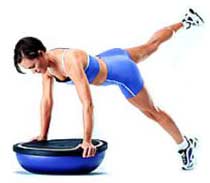
BOSU Ball Workouts are Non-stop, Fun, Challenging and Effective
As its name suggests the BOSU balance trainer allows you to work your balance. However, the BOSU balance trainer is not only limited to balance exercises.
This versatile fitness tool which no health club or home gym should be without can be used for strength, power, cardio, flexibility exercises, and balance training exercises.
A BOSU ball workout can be a very intense workout. The BOSU balance trainer allows you to work your body both anaerobically and aerobically with very little transition between exercises.
It is possible to center your entire workout around any number of BOSU balance trainers with or without any additional exercise equipment.
Benefit from BOSU Workouts 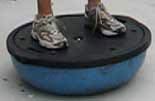

The BOSU balance trainer has the advantage over round stability balls because it is half domed. This allows for many unique benefits. This allows you to perform exercises on both sides of the BOSU. By using BOth Sides Up you can vary the degree of the balance needed to perform exercises as well as completely change some exercises around.
The BOSU balance trainer is durable and sturdy which allows you to perform many different types of jumping and explosive exercises which you could not do on any other piece of equipment. If you have more than one BOSU you can even do more exercises.
Yet another benefit of a BOSU ball workout is the weight which the BOSU carries. Each BOSU weighs around 13 pounds which allows you to use it as a form of resistance (weight) for exercises which isolate certain muscle groups as well as keep your heart rate up.
The best way to perform BOSU ball only workouts is non-stop. You can have different forms of exercises for multiple body parts and string them together in one very effective muscular strength and endurance and cardiovascular workout.
Each BOSU Ball Workout has Cardiovascular as well as Strength & Power Benefits
Can the BOSU Balance Trainer be Used with Other Equipment?
The BOSU can add a Manageable Balance Component to Most Free Weight Exercises
If balance is something you are concerned about improving you can stand on the BOSU balance trainer while you perform any movement with free weights.
This a great way to increase core stabilization and balance.
Since balance involves recruitment of more muscles, an entire free weights BOSU ball workout can also help you burn extra calories during your workout.
This is in addition to strengthening your stabilizer muscles and improving your balance.
In the video example (right) of BOSU squat w/ cable row you can see the constant movement (shaking) in the legs during the squatting motion.
This is because the instability of the BOSU causes the inner thighs, outer thighs and calves to contract to stabilize the body on the ball.
This motion without the BOSU would have far less muscle recruitment of the lower body.
You can Also Use the BOSU as a Weight Bench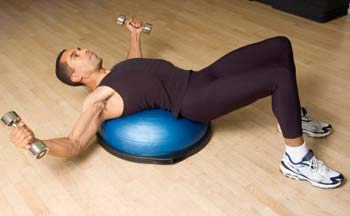
Similar to stability ball exercises, you can place your upper shoulders, head and back on the BOSU to form a bridge like position and use it as a weight bench for presses, chest flies and basically all exercises which you could do on a weight bench.
Stability ball exercises are better for this use but if a BOSU is what you have, you can use it as an efficient weight bench.
If you move your body further forward compared to the picture (right) you can work your glutes, hamstrings and lower back statically while you perform upper body exercises.
If storage space is a concern, a BOSU is a better option than a stability ball or a weight bench for people with some goals.
Where can You Find a Good BOSU Ball Workout?
For more information about workouts and custom workout programs for your specific goals check out the workouts page.
Create your Own Efffectvie BOSU Ball Workouts with the Following Exercises
- BOSU Ball Exercises
Get an idea for the method behind exercises for each body part which make up the best BOSU ball workout for your specific fitness goals and workout schedule - Workout Program Routines
Learn what exactly goes into a successful workout program. Learn how to maximize your time in the gym with the most effective exercises.

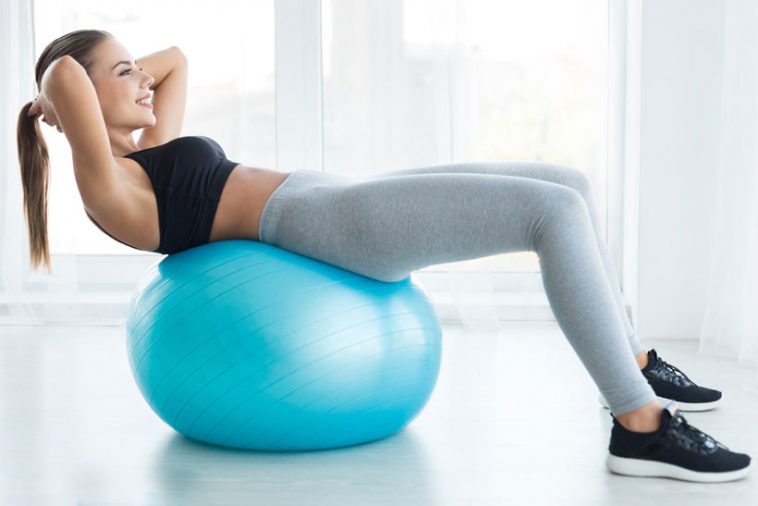
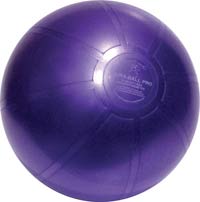
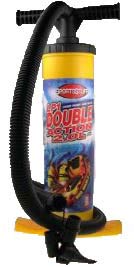
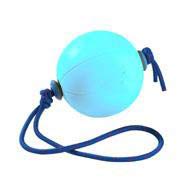

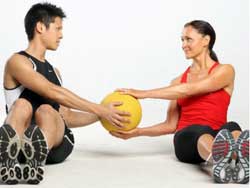


 Lats
Lats